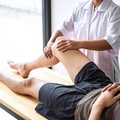
By Jordyn Mackonka, PT
Foam rolling has become increasingly popular over the past decade; you can’t go into a yoga studio, gym or rehab clinic without seeing several rollers lined up. With rolling becoming more mainstream there is the increased risk of its misuse.
So what exactly does foam rolling do?
Rolling is a form of self tissue massage or self myofascial release. The technique helps to rid your muscles and connective tissues of adhesions. Adhesions can create weak points in the tissue, leaving them more susceptible to injury. They prevent muscles from contracting in a uniform fashion from end-to-end, and this can lead to microtrauma and pain.
Foam rolling can also increase blood flow to your muscles. BLOOD = NUTRIENTS & OXYGEN, which means better performance and faster recovery from exertion.
When performed correctly foam rolling has great benefits. However, if used incorrectly foam rolling can irritate tissue and possibly cause further injury.
Training with a professional is the best way to learn how foam rolling can best serve you. In the meantime here are a few quick points on mistakes to avoid when testing out a roller.
1. Rolling too quickly: You are not getting rid of adhesions by rocketting back and forth. Allow time for your neuromuscular system to relax. Move slowly so that the superficial tissue can adapt to the compression. Feel the points of tension and use short, localized movements to roll over that particular spot.
2. Overkill on muscle knots: While you should spend time on localized points of tension, that does not mean you should place your entire body weight on the roller for 5+ minutes on one point, You can actually cause nerve and/or tissue damage. Spend 20 seconds on a tender spot and then move on.
3. Poor form & posture: As with weight training, yoga and any type of physical activity, proper form and technique matter. This is where consulting a professional comes into play. They can help you identify postural deviations and correct improper form. Also consider using a smartphone to record yourself to identify errors.
Foam rolling may be the perfect tool to help you on your way to recovery and prevent further injury. It is important to understand where your pain or dysfunction is coming from before you start rolling. Remember to stick with it! Repetition and consistency are key to maximize the benefits of self myofascial release.
Jordyn Mackonka is currently a licensed physiotherapist and acupuncture provider at Holland Landing Health Centre in East Gwillimbury, Ontario. If you have any further questions concerning foam rolling please contact Holland Landing Health at info@ HLHC.ca or 905-853-7900!

Admin
Contact Me


